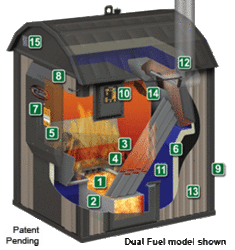Has anyone used this stove yet?
I have a 1962 3400sqft house that use to be my grand fathers it has 2 fireplaces in it but they are not for heat just looks. I am going to build a 24x32 garage soon and i want to add a outdoor wood burner beside it and heat the house along with the garage. The current furnace is killing me for heat this winter I paid $450-$500 a month for NG alone. I have hot water base board heat now. I have looked at the wood gasification stoves but i really don't want to hold heat in water and i don't want the wood inside the house. I saw on a web site that the E-Classic 2300 was 98% efficient could this be a mis-print.


one fire place

indoor grill.
I have a 1962 3400sqft house that use to be my grand fathers it has 2 fireplaces in it but they are not for heat just looks. I am going to build a 24x32 garage soon and i want to add a outdoor wood burner beside it and heat the house along with the garage. The current furnace is killing me for heat this winter I paid $450-$500 a month for NG alone. I have hot water base board heat now. I have looked at the wood gasification stoves but i really don't want to hold heat in water and i don't want the wood inside the house. I saw on a web site that the E-Classic 2300 was 98% efficient could this be a mis-print.
one fire place
indoor grill.


 Any other reasons that made you go this route other than the above? I must admit I too was thinking OWB but now I'm wrestling with a gassifier either indoor or outdoor. Plenty of $$ reasons to go with indoor but still have not received good WAF.
Any other reasons that made you go this route other than the above? I must admit I too was thinking OWB but now I'm wrestling with a gassifier either indoor or outdoor. Plenty of $$ reasons to go with indoor but still have not received good WAF.